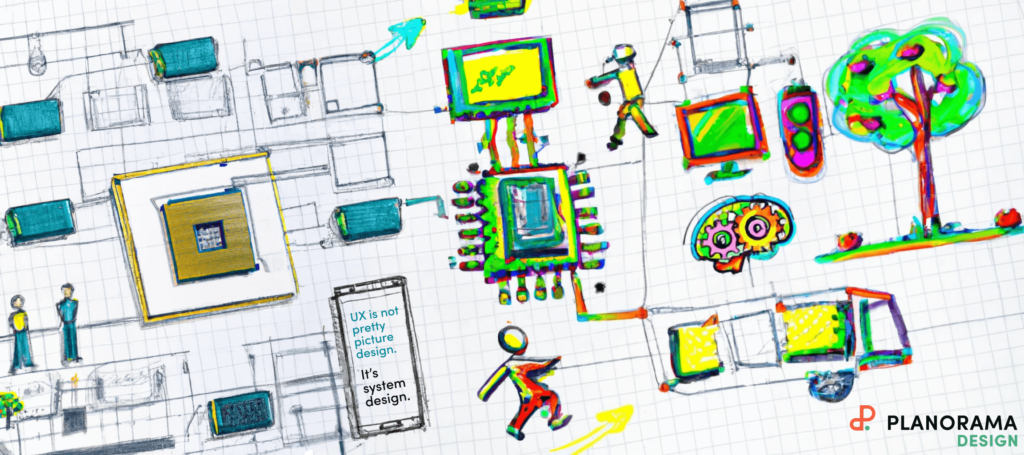BlogUX design isn’t about pretty pictures
There’s a common misconception that the role of User Experience design is to make screens look pretty. Let’s talk about that.
September 3, 2022There’s a common misconception that User Experience (UX) design for software makes screens look nice – clean, professional. Screens pop in the right places to capture the users attention (but not too gaudy; just the right amount of popping, please). “And make it minimalistic too.” If you’ve heard or uttered phrases like these before, you’re not alone. Many people believe that the primary role of UX is to make pretty pictures so customers will buy your product.
During my career in the semiconductor industry, it would have been absurd to suggest taping out a chip without design. Such a notion doesn’t even make sense. For every type of engineering project, design is a required step. Building a new bridge? Tweaking this model year’s truck for next year? Launching a rocket? Whether building something new or modifying an existing product, everyone would agree that design must happen before production.
When it comes to the engineering of software, ahh….this is where opinions about the necessity of design aren’t so unanimous. We hear statements like, “the product or dev team will design it”, or “we just need someone to make the screens [pretty].”
At this point, design is relegated to optional and reduced to artwork, because after all, “UX design is not as difficult as software development”. Then managers and directors wonder why projects go sideways, cannot deliver on time, blow the budget, or bring loads of bugs to market.
Let’s discuss UX design as an alternative that will avoid those pitfalls, where UX design is valued as more than creating simple and intuitive interfaces for users.
UX design is planning
Unfortunately, the term UX Design works against itself. Everyone hears the UX but not the design. I assert that “design” is the primary term. Why? Because design is nearly synonymous with planning, and in this case, planning how customers get value from your product via their interaction with it.
Taking a step back: Why do businesses create product roadmaps? So the product team, engineers and other stakeholders all look at the same plans (i.e. roadmap) of future solution capabilities. This enables sales to have meaningful conversations with customers about upcoming features. It enables development teams to consider code and data structures that will support those roadmapped features when it’s time to implement. And, designers create and build user interfaces that are flexible and extensible so roadmapped features fall into place without requiring a costly UI redesign.
Users should experience a software product that flows from feature to feature without dead-ends or detours. Customers experience the product’s value via the forethought and intentional planning of UX design.
UX design is requirements definition
In many product teams, new feature requirements come from product managers who have investigated and solidified the needs from the market and customers. Beyond functional requirements, software developers have to know how the features are presented to users, in detail. Specifying these essential elements is the realm of UX design, completing and documenting the associated visual requirements in detail such that the development team can execute. A well-functioning team of product management, UX design and software engineers will hone both the functional and visual requirements of workflows and screens before software development begins.
The alternative is to cut corners and double up product management and/or software development teams’ responsibilities to “do UX/UI design”. When UX designers are not present, developers slow down and must, “figure out where to put the button”, which translates into defining requirements within the development sprint! Developer efficiency is drastically reduced, penalizing the project with costly delays and repeated feature redesigns while customers walk away from the app.
UX design is system design
High functioning, experienced UX designers, like developers and architects, are equally concerned about the product and the system. After all, user interfaces are the one window users have into the operation of the entire system. For each software feature, a seasoned UX designer will want to know all the primary points of status, administration, and potential failure. Many types of features have dependencies on other system components, underlying infrastructure, API’s, hardware capabilities and their associated failure modes, performance, points of synchronous versus asynchronous communication, and more. Working together with engineering, designers contribute to creating responsive systems that present users with an interface to handle all exceptions and potential problems as gracefully as successful interactions with the product.
When UX design is not present, the same feature and system-wide exception cases still need to be prioritized and handled. Unplanned system exceptions tend to manifest in testing as unanticipated new work for the development team, or worse yet, in the field as product bugs that require redesign and/or redevelopment. In either case, cutting UX design corners spells delays and additional costs.

Wrapping up
Businesses that allocate for UX design and provide a seat at the table with product, architects, developers, and IT avoid costly problems that easily eclipse the cost of including UX design. The savings extend beyond the development costs and include reduced customer support and training costs, increased customer retention, and fewer bugs. Indeed, UX design is more than pretty pictures, especially if you wish to picture smoother running product development.
Illustrations by Matt Genovese and DALL-E 2
Don't miss out on the latest insights and trends in UX design and AI research! Subscribe to our newsletter.